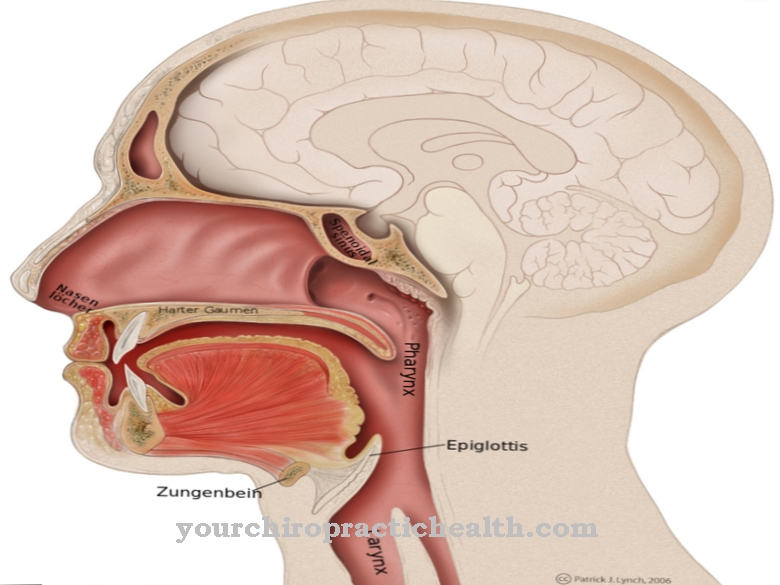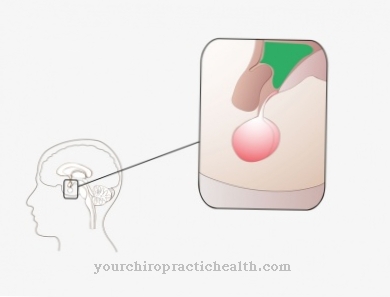The Tarsus connects the lower leg with the metatarsus. It is of outstanding mechanical importance in load transfer.
What is the tarsus?
The tarsus (tarsus) consists of 7 bones, which can be divided into 2 sections. The two largest bones, the talus and the heel bone (calcaneus) are found in the proximal area.
The second row is formed by the navicular bone (Os naviculare), the cuboid bone (Os cuboideum) and the 3 cuneiform bones (Os cuneiforme mediale, intermedium and laterale). The talus is connected to the ends of the two lower leg bones and together with them forms the upper ankle joint. It lies on the calcaneus, which is the only one of the 7 bones that has contact with the ground. Together with the navicular bone, the two bones form the lower ankle joint. The 3 cuneiform ossa and the cuboid bone articulate with the bases of the 5 metatarsals. All the tarsal bones form the rear foot, which is followed distally by the metatarsus and finally the toes.
Anatomy & structure
The underside of the tibia and the insides of the two ankles, which form the malleolar fork, unite with the talar roll to form the upper ankle. Due to the shape and the strong tension in this system, only movements in one plane are possible there, lifting (dorsiflexion) and lowering (plantar flexion) of the foot.
The largest tarsal bone, the calcaneus, is located under the talus and together with it forms the posterior chamber of the lower ankle. The talus head (caput tali) protrudes like a rounded cylinder into the distal area of the tarsal. It has 2 convex articular surfaces with which the calcaneus and the navicular bone connect to the anterior chamber of the lower ankle joint. Combined rotary movements of the foot can be performed here. All other bone connections between the tarsal bones and to the metatarsals are so strongly secured by tight ligaments that only slight shifts are possible (amphiarthroses).
The calcaneus and the cuboid bone form the foundation of the longitudinal arch of the foot. The talus and all other tarsal bones lie bony and tied on these two and form the beginning of the bridge construction, which continues in the metatarsus and ends at the metatarsophalangeal joints.
Function & tasks
The movements of the foot are largely determined by the upper and lower ankle joint and the controlling muscles. In the swing leg phase, the foot is brought into a position when walking and running in a combination of dorsiflexion in the upper and lifting of the inner edge (supination) in the lower ankle joint, which allows the free leg to be guided unhindered.
When jumping, there is rapid plantar flexion using the strong calf muscles that attach to the cusp of the calcaneus. The remaining connections between the tarsal bones and the metatarsal bones, which are only slightly displaceable, give the foot overall a certain stability, but nevertheless allow it to adapt to unevenness when stepping on.
The bony construction of the longitudinal arch is supported on the one hand by strong bands under the sole of the foot, the ligamentum plantare longum and the plantar fascia. On the other hand, the tendons of the toe flexors partly run on the inside under the arch of the bridge and also help with this function. This creates a buffer system that is able to absorb shocks and heavy weight loads in a springy manner and to protect the joints of the foot, legs and spine.
The tarsal bones are the most massive of the foot skeleton. This equips them very well for the task of bearing the burden of their body weight. Due to the unique construction of the tarsal, the load is distributed very favorably and the stress on the individual parts is significantly reduced. Due to its central position, the talus is the switching and distribution center in this process. The weight that comes from above is transferred to him through the shin. A large part is passed on to the massive calcaneus and from there reaches the ground. The rest of the load is transferred via the anterior chamber of the lower ankle joint to the adjacent tarsal bones and further via the arch structure to the forefoot. This creates a load distribution across many elements with a low load on the individual parts.
Diseases
All tarsal bones are at risk of fracture from trauma caused by direct or indirect violence. The calcaneus is affected if you land on it after falling from a great height, such as accidents at work and attempted suicide.
Talus fractures can occur when excessive force is applied to the ankle.Such injuries are typical sports injuries in which the affected person twist ankle while simultaneously acting on the opponent's side or fixing the foot. Similar injury mechanisms can also cause fractures in the other tarsal bones. This often leads to problems with bone healing. Either bumps remain, for example in the talus with subsequent osteoarthritis, or metabolic disorders cause the bone material to lose substance.
The sphenoid bones in particular can be affected by so-called fatigue fractures. They arise as a result of excessive stress during sporting or professional activities. In contrast to acute fractures, the problem develops gradually and is often not recognized at the beginning because the symptoms are very unspecific.
A flattening of the longitudinal arch, the so-called arches, naturally also affects the tarsal bones. The tape securing below the arch gives way due to excessive load and insufficient resistance and the arch gradually becomes flatter. In the final stage, the entire row of tarsal bones that lie on the calcaneus and the cuboid bone slips off. The underside of the 3 cuneiform bones and the navicular bone reach the floor and come into the zone of pressure load. This stress causes severe pain and must be passively corrected with appropriate insoles.



























